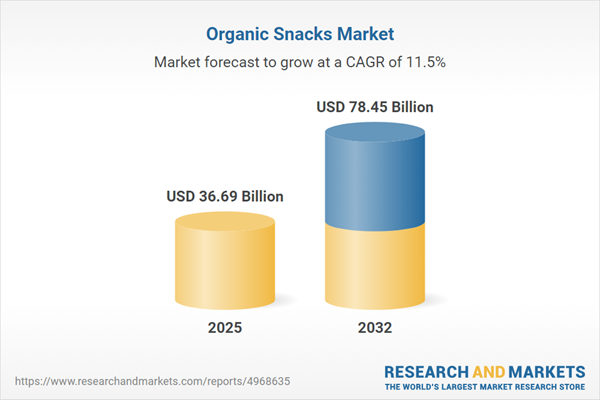Speak directly to the analyst to clarify any post sales queries you may have.
The organic snacks market is witnessing swift evolution, driven by changes in consumer preferences, regulatory shifts, and advancements in technology. For senior decision-makers, insight into these factors is essential for capitalizing on emerging trends, mitigating risk, and maintaining a competitive edge within the marketplace.
Market Snapshot: Organic Snacks Market Size and Growth Outlook
The organic snacks market has achieved robust growth, primarily attributed to increased health consciousness and rising expectations around product transparency and clean-label certifications. Leading companies are prioritizing targeted innovation, adopting advanced research and development alongside improved manufacturing practices to meet consumer demand for nutrient-dense, transparent, and ethically sourced snack solutions. Additionally, increased attention to supply chain transparency and meeting compliance standards has reinforced integrity across the sector. Organizations demonstrating agility and aligning quickly with both evolving consumer behaviors and regulatory frameworks are setting the pace, while the ability to manage operational complexity on a global scale further distinguishes frontrunners in this competitive arena.
Scope & Segmentation: Organic Snacks Market
- Product Types: Includes cereal bars, fruit and nut bars, chips from grains and vegetables, a broad variety of dried fruit snacks, nut and seed snacks such as almonds and pumpkin seeds, snacks derived from root vegetables, and assorted popcorn varieties. Each segment is developed to align with consumer expectations for nutrition, ethical sourcing, and ease of consumption.
- Distribution Channels: Spans convenience stores, mainstream supermarkets, specialty organic retailers, and a growing range of digital sales platforms, facilitating tailored go-to-market approaches by geography and customer profile.
- Price Ranges: Covers budget-oriented private labels, mainstream options, and premium organic selections, supporting diverse customer values and strengthening positioning for both value-driven and ethics-conscious consumers.
- Pack Sizes: Offers single-serve, family, and multi-serve formats to fit the varied purchasing and consumption patterns of modern consumers and address different usage occasions.
- End Users: Targeted for adults, seniors, and young people (ages 2 to 17), allowing manufacturers to create specialized products that address unique nutritional, wellness, and preference-based requirements.
- Regions: The market footprint spans North America, Latin America, Europe, the Middle East and Africa, and Asia-Pacific, including enhanced attention to local markets such as the United States, Brazil, Germany, China, and India. Regional adaptation in product development and compliance supports broad-based growth and localization strategies.
- Technologies: Deployment of machine learning advances consumer insights, improves product quality assurance, and fosters digital engagement, positioning companies to adapt more swiftly and with greater precision to changing market signals.
Key Takeaways for Decision-Makers
- Prioritizing transparent and health-centered product ranges increases consumer trust, supporting long-term brand equity in the organic snacks sector.
- Utilizing both digital sales and traditional outlets effectively widens reach into diverse markets and streamlines consumer acquisition strategies for new and emerging segments.
- Adopting sustainable packaging and maintaining visibility across the supply chain are increasingly critical for responding to compliance mandates and appealing to partners and customers with strong environmental values.
- Leveraging analytics and implementing agile production systems boosts responsiveness in the face of supply chain disruptions and strengthens the management of rapidly shifting risks.
- Regional customization in sourcing and development improves speed to market and keeps brands in sync with regulatory requirements and evolving consumer demand patterns.
- Introducing well-designed premium organic snack lines unlocks higher returns in markets where there is consistent appreciation for ethically produced and value-focused offerings.
Tariff Impact: United States Value Chain and Sourcing Strategies
Recent changes to U.S. tariff regulations on organic ingredients and snack products are influencing many manufacturers to prioritize domestic supply chains. This strategy is delivering benefits such as enhanced supply reliability and greater distribution efficiency, while also supporting compliance with certification standards and contributing more meaningfully to local economic development.
Methodology & Data Sources
This report employs established methodologies, including Porter’s Five Forces and SWOT analysis, to ensure rigor in strategic recommendations. Data sources include government publications, academic studies, and in-depth interviews with industry and supply chain experts, facilitating robust validation of all market insights.
Why This Report Matters
- Equips executives to fine-tune their organic snack portfolios and future-proof strategies as regulatory conditions and market expectations evolve.
- Clarifies how supply chain innovations and compliance priorities influence resilience and commercial viability.
- Provides timely updates on technology and consumer behavior trends, supporting sharper decision-making and sustained market relevance.
Conclusion
Continued focus on transparency, responsive innovation, and strategic adaptation positions industry leaders to succeed and sustain growth in the dynamic organic snacks market.
Additional Product Information:
- Purchase of this report includes 1 year online access with quarterly updates.
- This report can be updated on request. Please contact our Customer Experience team using the Ask a Question widget on our website.
Table of Contents
3. Executive Summary
4. Market Overview
7. Cumulative Impact of Artificial Intelligence 2025
Companies Mentioned
The companies profiled in this Organic Snacks market report include:- General Mills, Inc.
- The Hain Celestial Group, Inc.
- Clif Bar & Company, LLC
- Nature's Path Foods, Inc.
- KIND LLC
- Kellogg Company
- PepsiCo, Inc.
- Danone S.A.
- Nestlé S.A.
- Hormel Foods Corporation
Table Information
| Report Attribute | Details |
|---|---|
| No. of Pages | 186 |
| Published | October 2025 |
| Forecast Period | 2025 - 2032 |
| Estimated Market Value ( USD | $ 36.69 Billion |
| Forecasted Market Value ( USD | $ 78.45 Billion |
| Compound Annual Growth Rate | 11.4% |
| Regions Covered | Global |
| No. of Companies Mentioned | 11 |









